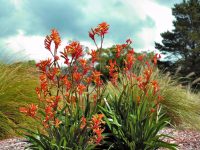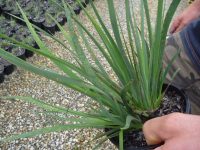It’s been a busy Spring for me, so apologies that there have been no newsletters for a while. I’ve been working away on plans for my property, plenty of horticultural therapy in my garden and out bushwalking, and on some exciting projects I look forward to sharing more about in the future. One of the projects I am excited about is the Macquarie Point Development in my new home state of Tasmania. This is a 9 hectare waterfront site, which in its previous life as a rail head adjoining the docks in Hobart, had to deal with various industrial products and workings. It is now in the process of being remediated and turned into an impressive new area for locals and visitors. There are plans to include community and cultural events, education and performances. I am involved in one part of Mac Point, the Edible Precinct. I’ve been collaborating with one of my favourite urban farmers, Tino Carnevale and Kris Schaffer, an Aboriginal horticulturist and brilliant bush food educator. The project is a marvelous experiment in sustainable urban farming and the gardens created will be both a productive garden and a great educational resource and experience for visitors to the site. I’m excited to be part of a project which will educate about Tasmanian aboriginal culture and plant use.
It has also been a great opportunity to experiment with the use of larger scale worm farm and composting systems, which are incorporated into the site to create a sustainable supply of rich topsoil for the reclaimed industrial land, as well as producing liquid feed for the plants grown there. We’ve been getting great results with this. Edible plants are the main focus of the garden, which is based around bringing people together and sharing knowledge and traditions around food. This means I’ve been able to combine some of my favourite bush food plants with non-native food plants to tell this story, and to show the relationships between our native food plants and their more commonly known botanical relatives. The garden will also supply native food plants to other organisations in the greater Macquarie Point site, and is currently on track to open to the public early this year. It is exciting for me to go from small scale edibles, compost and worm production at my own place, to large scale efforts. The growing systems we have set up are very do-able on a smaller scale, as well as working admirably on quite a large area. The hope is that people once people see the results, they will be inspired to grow and recycle in their own local home edible precincts!
Plant of the Month- “Rampaging Roy Slaven”
The Kangaroo Paw is one of my absolute favourite natives, and this variety is one of many that I’ve created over the years to bring the beauty of the wild kangaroo paw and it’s brilliant range of flower colours with the home garden and wider Australian landscape. This particular variety has a bit of a story to it, involving an old friend of mine and a wonderful Australian charity organization –
***https://www.youtube.com/watch?v=_fWG6uDBMEs ***
A medium sized and reasonably tough variety from the Bush Gems Landscapers series, it has iridescent sunset red-orange colours in the flowers. “Rampaging Roy Slaven” is suitable for landscaping, garden or container planting. The bright flowers attract native birds and pollinators to the garden and also make great cut flowers. When selecting a plant to buy, one thing to keep an eye out for is small orange spots which can indicate the presence of Rust.
Look for plants with clean foliage to avoid bringing this fungal disease into your garden. Ideally prevention is the best cure in this case! Though I should mention that the tall kangaroo paws are not troubled by rust, so if you want to avoid it, use any of the colours in my Tall and Tough Landscape varieties (Scarlet, Gold, Tangerine, Lilac, Yellow, Orange, Lime), as well as Yellow Gem, Big Red, Federation Flame.
I’ll be putting up some good info on identifying and dealing with Rust on the website soon so keep an eye out for that. I’m also looking forward to sharing more updates on what’s happening on my farm as I get in and start establishing my own plantings and gardens on what is essentially a blank canvas at the moment. Part of the aim of my farm planting will be exploring more Australian plants for useful botanical products that can be grown and further developed here in Australia.
Australia’s native plants hold a wealth of useful compounds, and I love this new journey, discovering more about the unique components that are created by plants, and exploring the relationship between humans and plants, and traditional knowledge and uses of native plants in particular. I’m taking a break from travel and touring this year so as to have more time to invest into this area, starting with selecting a collection of many different plants with possibilities for new compounds. There are many purposes these can be put to, from creating new essential oils, to flavourings for foods and drinks, to medicinal. When you consider that an essential oil from one plant can sometimes have a hundred or more different components, it gets to be a complicated project!
I’m working away on the Pure Oils Of Tasmania range, as it expands into new products, and we test new uses. We now have a stall at the well known Salamanca Markets in Hobart, every Saturday. Come and check out the essential oils and the products we are developing, as well as my books and cards. I’ll be there as my time allows. If you can’t get to the Salamanca markets, then explore the website for Pure Oils Of Tasmania>>>>>or find the range on my shop >>>>
Koonya Garlic Festival
Saturday February 23rd, 2019 , 10.30am – 4.30 pm, 564 Nubeena Road, Koonya, Tasmania. Entry : $10 adults, children under 16 free, locals $5
More about the wonderfully quirky garlic fest here>>>
I first got involved with this event around four years ago, and the wonderful community spirit and simple fun of it was one of the things that sealed my desire to move to Tasmania. My good friend Tino Carnivale will also be there to share the love of Tasmanian grown garlic.
Koonya is only an hour’s drive from Hobart airport if any of you mainlanders want to experience the delights of a regional food and gardening festival in Tasmania.
This Long Weekend – Plant An Australian Plant
Head to your local nursery and buy an Aussie plant or two or more to add to your garden, or to someone else’s garden! A phrase that really resonates for me is from our First Nation People- ‘Caring For Country’. We can all do our bit of caring by improving our surroundings to create habitats and more useful spaces. Get creative, find something edible, or to bring shade to a hot area, something beautiful, or good for wildlife, ones for cut flowers, or quirky plants.
These are some of my favourite specialist nurseries for Australian plants-
The Wildflower Place on the NSW central coast
Cool Country Natives in the ACT
Zanthorrea Nursery in Perth


